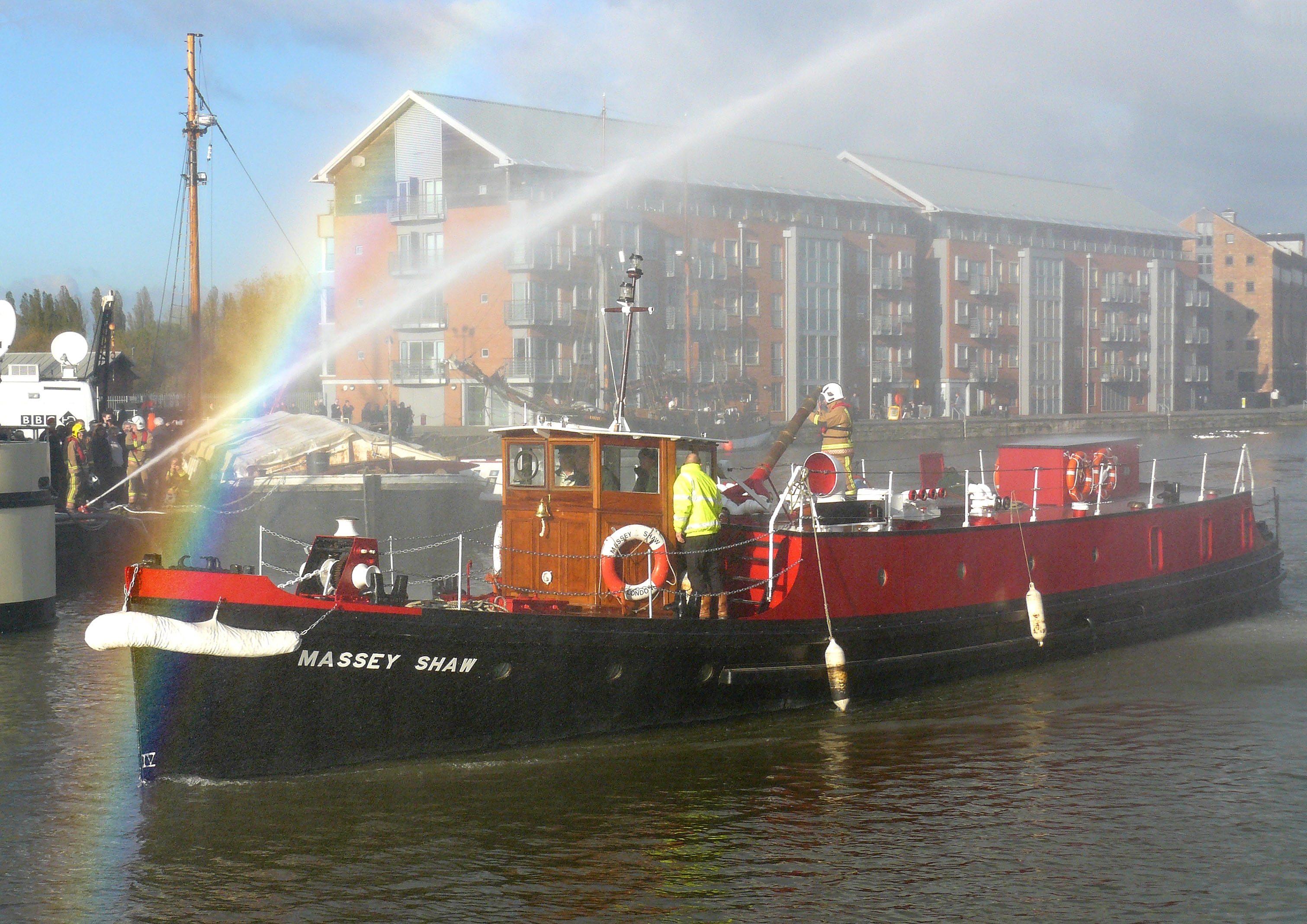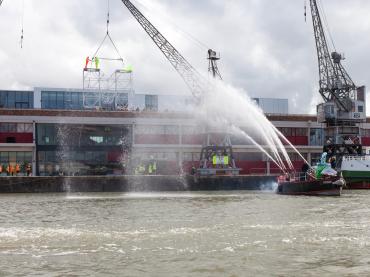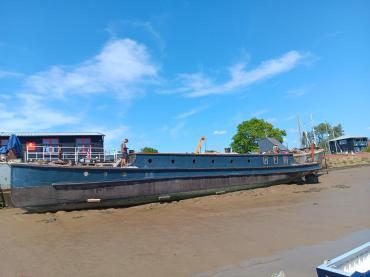


Details
Construction
Dimensions
History
MASSEY SHAW was built by J Samuel White of Cowes, Isle of Wight in 1935. She was built to a design of the London County Council, who wished her to be able to go under all the bridges of the Thames and its tributaries at any state of the tide. The vessel cost the sum of £18,000 to complete. She was powered by two Gleniffer DC8 eight cylinder diesel engines which were connected to two Merryweather four stage fire pumps.
MASSEY SHAW was heralded as a great addition to the fire fighting capabilities of the London Fire Brigade's River Service. Within a few months, she had demonstrated her full capabilities whilst fighting a large warehouse fire at Colonial Wharf, Wapping. The fire had gained hold of an eight storey warehouse complex and fire fighting operations were hampered by difficult access. MASSEY was able to supply a vast jet of water that made a ‘firebreak’ and allowed the land-based crews to regroup and stop the fire spreading. Newspapers at the time credited MASSEY with saving over a million pounds worth of stock, by preventing the fire moving along to other adjoining warehouses.
MASSEY's finest hour came in May 1940 when she answered a call from the Home Office asking her to take part in ‘Operation Dynamo’. She made three trips to the beaches with her volunteer crew of LFB, AFS and NFS Firemen, rescuing some 500 troops from the beaches and bringing back a further 110 to Ramsgate. In addition to this work, on her return to London MASSEY rescued thirty French merchant seamen when their vessel hit a mine. On her return to her home port, MASSEY was heavily involved in fire fighting operations during the Blitz. Her fire pumps provided vast amounts of water to quell the large number of fires in the Docks and surrounding areas.
MASSEY continued as an operational fireboat on the Thames until 1971, when she was decommissioned by the London Fire Brigade. After this period, she was moved to different locations on the Thames whilst the Fire Authority decided what should be done with her. One of the most notable ideas was that MASSEY would be placed in dry-dock in the Thames Mead Housing Estate, befalling a similar fate as the CUTTY SARK.
In the early 1980s she was moved to St Katherine’s Dock, by Tower Bridge, where she was seen by several enthusiasts. At this time, MASSEY was looking a sorry state, she was being used as a walk way for people to get to other craft and her general condition was poor. Undeterred, these individuals decided to form a preservation group to restore this historic craft to her former glory on the Thames. Many ‘battles’ were fought along the way with the Fire Authority (who still owned the boat) and various other organisations who had their doubts about handing MASSEY over to this unknown group.
Finally, The Massey Shaw & Marine Vessels Preservation Society were given a fifty year lease on the vessel from the Fire Authority, and began to restore her to working condition. In the autumn of 2008, it was reported that she was currently in Deptford Dock undergoing restoration by the Massey Shaw Society. One of her main Glennifer diesel engines was awaiting a full rebuild over the winter. The aim of the Society was to complete the restoration of the fire boat so that it can be used as a floating educational resource on the Thames. On 31 March 2011, MASSEY SHAW travelled from South East London to Gloucester where restoration work was carried out at Tommi Nielsen's yard, she returned to the Thames in 2013 and is moored in West India Dock E14.
MASSEY SHAW is now able to accept visitors by appointment - details on our website www.masseyshaw.org
Significance
1. What is the vessel’s ability to demonstrate history in her physical fabric?
Evidence for designs, functions, techniques, processes, styles, customs and habits or uses and associations in relation to events and people. How early, intact or rare these features are may impact on significance.
MASSEY SHAW was a purpose built fire float for the River Thames and her riveted steel hull, light build construction and teak deck were an integral part of her design. Her dimensions were drawn to allow her to access the canal system and smaller tributaries off the Thames for firefighting and salvage operations. In order to ensure she could reach the desired speed of 12 knots, the builders and her commissioners (the London County Council) spent over 6 weeks at the National Physical Lab tanks in Teddington refining her hull shape until her speed could be confirmed. For longevity, the steel hull and fittings were galvanised.
MASSEY SHAW was the most powerful fire float on the River Thames, producing 3,000 gallons of water at pressures up to 250 psi, from her main water monitor or eight deck outlets. The water was produced from two four stage Merryweather fire pumps which were adapted to link in with the vessel’s two eight cylinder Glennifer diesel engines. She could provide “Salvage“ facilities for sinking vessels or other situations with two inlets on her deck which, when connected to a reinforced hose, allowed water to be sucked up and pumped away, thus keeping the endangered craft afloat. In the 1960s, the coal fired stove/range in the galley was replaced with an oil fired system. The two J.S. White’s auxiliary engines in the engine room were also removed and replaced with a new generator and compressor set.
She underwent full conservation in 2010 and is now approximately 85% original. Some of her steel hull fabric has been replaced and her teak decking has also been removed. The salvageable teak decking has been incorporated in the vessel to make floorings, galley fittings and storage racks for firefighting equipment. The original fire pumps and deck fittings remain plus some of the firefighting equipment. The vessel did not have a wheelhouse when it was built, and this was added in 1947 to provide protection to the coxswain and crew members. Some damage to the vessel in the form of dents to the hull has been left in place to contribute to the story of its working life. The main Gleniffer marine diesel engines were also overhauled, with the work done sympathetically using original parts and techniques, as they are believed to be the last operating engines of this type in the UK.
To meet MCA requirements and coding, the vessel’s fabric has been superficially adapted in some places. Examples of this include: an additional wire added to the deck rails; removable chains placed at the bow and stern to prevent passengers falling; and a radar system in the wheel house. All the changes have been done sympathetically, with original materials and construction techniques used wherever possible.
2. What are the vessel’s associational links for which there is no physical evidence?
Associations with people or places. Off-ship research.
MASSEY SHAW was built by J Samuel White of Cowes, Isle of Wight, and was used as an operational fire float with the London Fire Brigade for thirty six years, giving her significant associations with the capital. During this time she was crewed by numerous firemen and took part in several emergency situations. She is named after Captain Sir Eyre Massey Shaw, an important Victorian Fire Chief in charge of the newly formed Metropolitan Fire Brigade from 1866. In her first major fire in 1936, MASSEY SHAW is credited with helping to save over £2,000,000 of stock from being destroyed at the Colonial Wharf Fire in Wapping.
She gained international significance for her role during the evacuation of Dunkirk in May 1940, when she was sent by the London Fire Brigade to Dunkirk to fight fires in the town’s oil refineries. On arrival, this task proved impossible and so she assisted in ferrying troops to the larger vessels and back home, making three trips across the channel, rescuing over 500 troops from the beaches, and bringing a further 110 back to the UK. She was the only fireboat to take part in the evacuation and received a special mention from Vice Admiral Ramsey for her efforts. For the remainder of the War, MASSEY SHAW fought fires in the London Blitz, attending many major incidents, including the firebomb raid on St Pauls on 30 December 1940. In late 1947, she undertook a secret trip down the Thames with a number of important government officials, including the Labour Health Minister Aneurin Bevin. It was later revealed that this meeting was to finalise paperwork for the National Health Service.
MASSEY SHAW remained in commission until 1971, after which she became part of the Maritime Trust collection, based at St Katherine’s Dock. She has been featured in several films including: Dunkirk, The Battle of Britain, various TV documentaries and news programmes. She is well documented with her archive including photographs, newspaper articles, original plans and other memorabilia. MASSEY SHAW was the last remaining operational fire float of her type and has been recorded on the National Register of Historic Vessels since 1996, with National Historic Fleet status.
3. How does the vessel’s shape or form combine and contribute to her function?
Overall aesthetic impact of the vessel, her lines, material she was built from and her setting. Does she remain in her working environment?
MASSEY SHAW’s primary function was as a fireboat and her shape is determined by this use. Her shallow draft and beam were designed to allow her to operate off the main river and to pump water when the river was at low ebb. This ability is still retained today. A number of adaptations were made during her career, but all with the intention of improving her firefighting ability and the crew’s safety. Following a sympathetic conservation, she is aesthetically pleasing and technically interesting as a preserved working fireboat, with all mechanical elements in good operational order. She remains on the Thames at West India Dock, Poplar, in the area which she would have protected during her earlier career. She attends a number of events each year and is available to visit by appointment when not attending displays in and around the Thames.
Source: Massey Shaw & M.V. Preservation Society, 01 February 2017.
Key dates
-
1935
Vessel built by J. Samuel White, Cowes, Isle of Wight, for London County Council use on the Thames
-
1936
Attended a major fire at Colonial Wharf, Wapping. Vessel credited with saving £2 million worth of stock
-
1940
Took part in Operation Dynamo making three trips to Dunkirk and rescuing some 500 troops
-
1940-1942
Desperate fire-fighting during the ‘blitz’
-
1947
A permanent, wooden wheelhouse replaced the open canvass ‘dodger’ offering protection to coxswain and river pilot
-
1960s
Vessel became a reserve boat. New boats had taken over first-line duties
-
1969
Attended a chemical fire at Dungens Wharf on the Isle of Dogs to provide additional pumping capacity
-
1971
Decommissioned by the London Fire Brigade (LFB) and moved to different locations on the Thames pending LFB’s decision on her future
-
1980
Moved to St Katharine Docks and abandoned
-
1982
The Massey Shaw and Marine Vessels Preservation Society Ltd. was founded and the vessel given to the Society on a 50 year lease
-
1990
Sunk close to the LFB Headquarters at Lambeth, but salvaged so work could begin again
-
1990
Attended the Association of Dunkirk Little Ships’ 50th Anniversary return to Dunkirk
-
2000
Attended 60th Anniversary Dunkirk return
-
2008
Society granted £500,000 from Heritage Lottery Fund for restoration work and an educational project
-
2009
Vessel lifted out of the water onto hard standing at South Dock Marina, Southwark
-
2011
Vessel moved from South East London to Gloucester to complete restoration at Tommi Nielsen’s yard
-
2013
Massey Shaw returned to London following her restoration
-
2015
Massey attended the ADLS Return to Dunkirk with Little Ships
-
2018
Massey Shaw sustained damage to one of her main engines following a trip with ADLS to Ispwich. Repairs are on going
-
2023
Now able to accept visitors by appointment - details on our website www.masseyshaw.org
Grants
-
1 June 2016
£96,000 awarded to the Massey Shaw and Marine Vessels Preservation Society Ltd from the Heritage Lottery Fund towards the cost of transition funding
-
2009
A Sustainability Grant of £500 for a survey was made from the Strategic Development Fund of National Historic Ships
-
2008-2009
The Heritage Lottery Fund awarded £992,00 for a restoratin and educational project
-
2007
An award of £200 to cover the costs of attendance at the RINA Conference was made from the Strategic Development Fundof National Historic Ships
Sources
Brouwer, Norman J, International Register of Historic Ships, Anthony Nelson, pp162, Edition 2, 1993
Brann, Christian, The Little Ships of Dunkirk: 1940-1990, Collectors Books Ltd, 1989
Classic Boat: Fire and Water, July 2000
Classic Boat, June: 'The boat that saved St Paul's', June 2014
Own this vessel?
If you are the owner of this vessel and would like to provide more details or updated information, please contact info@nationalhistoricships.org.uk














